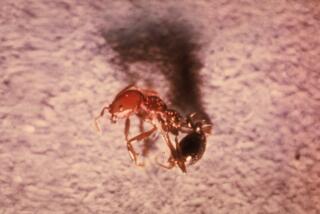Harlequin ladybird can be a pest in disguise
The harlequin ladybird was once a stalwart ally of greenhouse growers around the world. Native to Japan, Korea and other parts of eastern Asia, the bright red ladybugs were prized for their aphid-eating abilities — until they caused serious declines in other ladybug populations.
Now researchers have discovered the harlequin ladybird’s secret weapon: a deadly parasite that lives harmlessly in its body but kills other species with abandon.
The findings, published this week in the journal Science, demonstrate how things can go awry when a foreign creature is introduced into an ecosystem, even when done with the best intentions.
Ladybugs are beloved by humans and are particularly valuable to gardeners, who deploy the spotted beetles to eat plant-munching aphids rather than spray their shrubs, flowers and crops with harsh chemical pesticides. It’s a prime example of an environmentally friendly agricultural practice known as biological control.
But one particular ladybug, Harmonia axyridis, has proved to be a two-faced friend. These bugs gobble up aphids at jaw-straining speeds but spread like wildfire once they escaped the greenhouse, quickly taking over native ladybugs’ turf in large parts of Europe and North America, among other regions.
In Europe, swarms of the pests have started taking wintertime shelter in houses, said study co-author Heiko Vogel, a biologist at the Max Planck Institute for Chemical Ecology in Germany. Vogel’s own mother’s residence has been plagued by the beetles, which can fly through windows, slip under carpets and burrow into any crevice a human home has to offer.
“Thousands of beetles — even if they are nice-looking — crawling into your house is not fun,” Vogel said.
Scientists aren’t sure why some species are able to thrive and dominate when introduced to a new environment. In extreme cases, the invaders wipe out the resources of native predators and throw the ecosystem wildly out of balance. The Harmonia ladybug has been studied for years, but scientists hadn’t uncovered many clear answers that explain their success.
To take another crack at the question, German researchers analyzed the ladybugs’ hemolymph — its blood, essentially — under a microscope. They knew from earlier work that the beetles’ hemolymph contained an alkaloid compound called harmonine, which has very strong anti-microbial properties that allow the beetles to resist infections. (It’s so strong, in fact, that it’s being studied as a way to help fight microbes like Mycobacterium tuberculosis and Plasmodium falciparum that cause serious diseases in humans.)
Was harmonine a secret ladybug bio-weapon? It was a plausible theory: Previous research showed that native ladybugs who fed on Harmonia eggs and larvae became sick and died. Invasive Harmonia ladybugs, on the other hand, could feed on the young of other species without suffering any ill consequences.
But the harmonine alone couldn’t be poisoning the native species because when Vogel’s team pumped the beetles full of synthetic harmonine, they survived just fine. Something else in the harlequin ladybirds’ blood was causing the deadly effects.
“There must be some other player in the game,” Vogel said. “That’s why we started to look more closely into the hemolymph.”
When the researchers examined the Harmonia beetles’ blood, they found extremely high spore counts of a parasitic, single-celled fungus related to Nosema thompsoni. Indeed, the counts were so high that they thought they had made a mistake, Vogel said.
With so many spores in their hemolymph, “you should be dead,” Vogel said. But his team found the same high levels in hundreds of individual beetles.
The researchers soon realized that this must be the key to the Harmonia beetles’ success.
Somehow, their immune systems had managed to tame the spores — they weren’t eradicated, but remained in a handy, inactive state. Then, when gobbled by another species of ladybug, the spore would infect — and perhaps spread through the native population.
“It was a surprise,” said Stuart Reynolds, an evolutionary immunologist with the University of Bath in England, who was not involved in the study. “The harlequin ladybird is one of the best studied invasive insects there is, and nobody had any idea.”
Reynolds compared the scenario to the way European settlers wiped out Native American populations simply by introducing diseases carried in their bodies.
Such a bio-weapon should take a toll on the harlequin ladybirds’ fitness, Reynolds said. But clearly, the benefits outweighed the costs.
The findings offer a cautionary tale for biological control, which has been used with great success to control invasive pests, the scientists said. Even with rigorous testing, there may be unpredictable factors that could allow a foreign species to alter a native environment in unforeseen ways.
“You should think twice before you introduce an alien species into a new environment, even if it’s for a good reason,” Vogel said.







